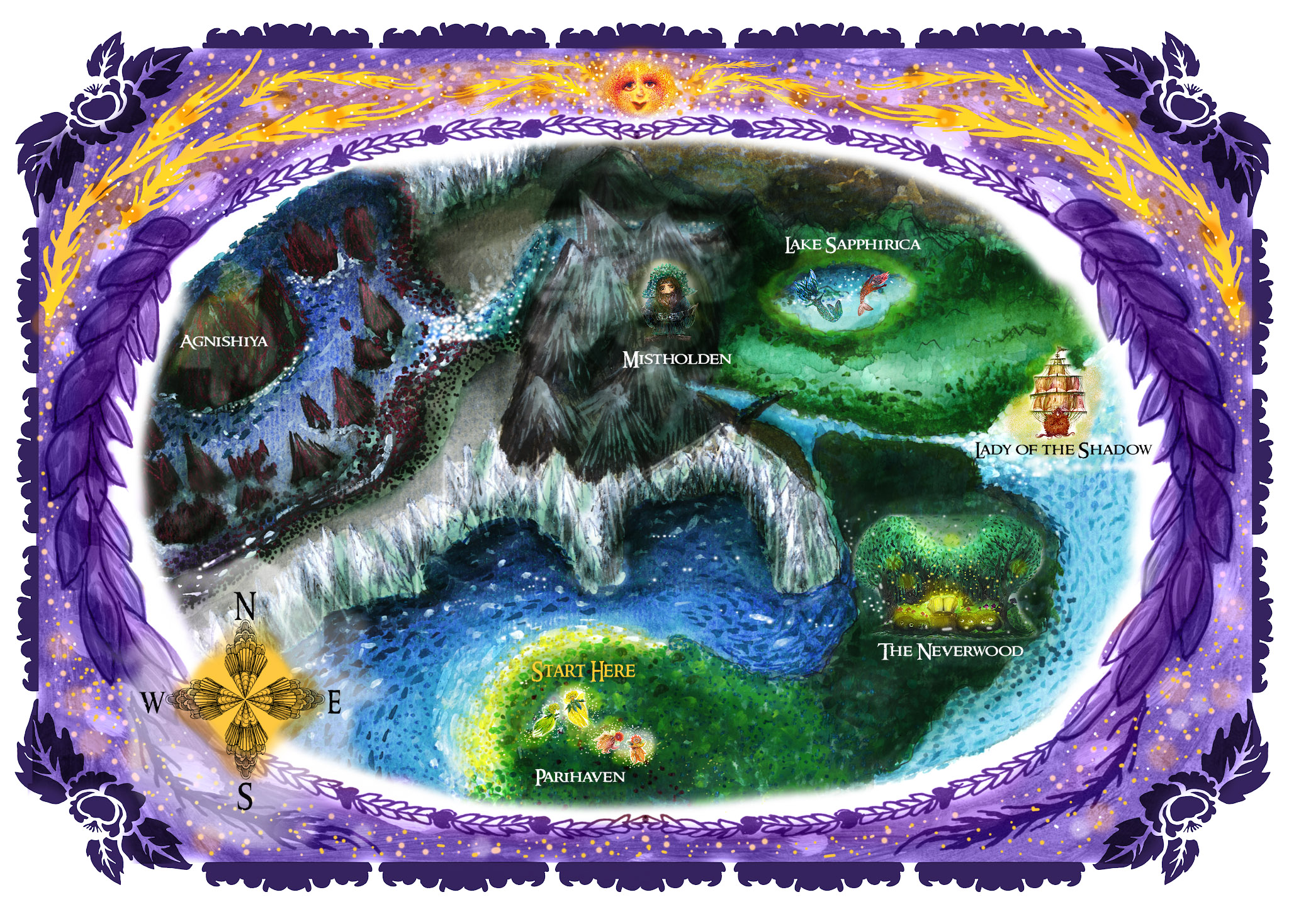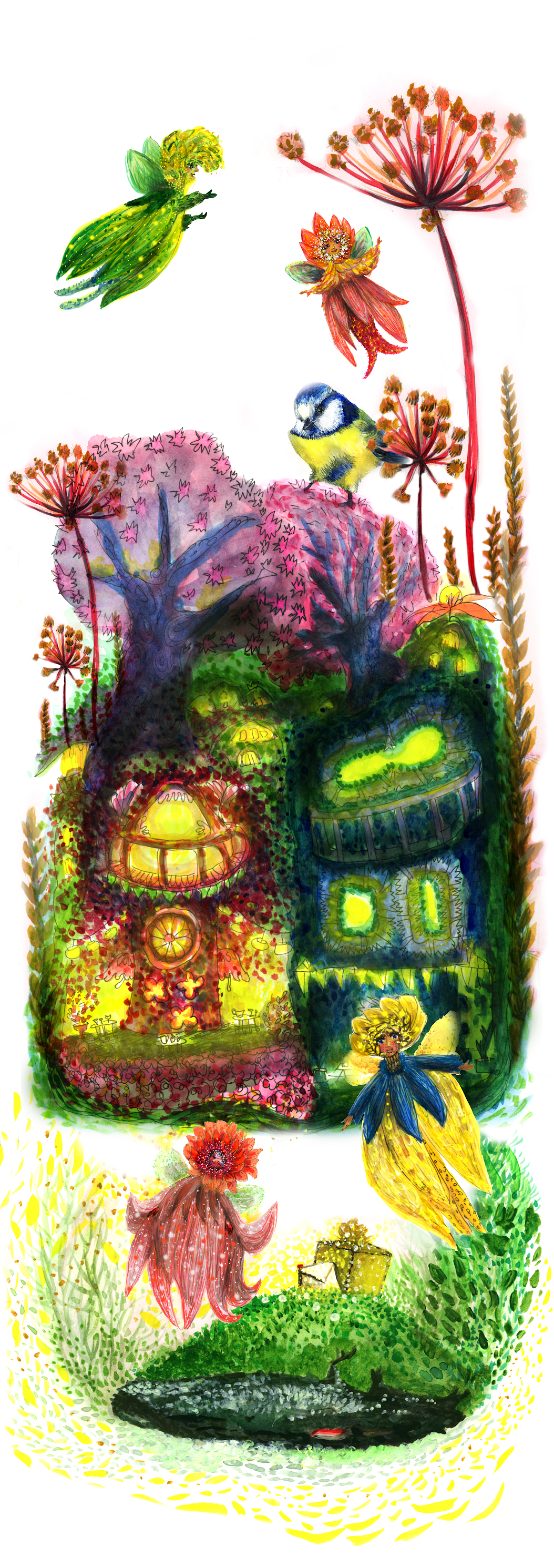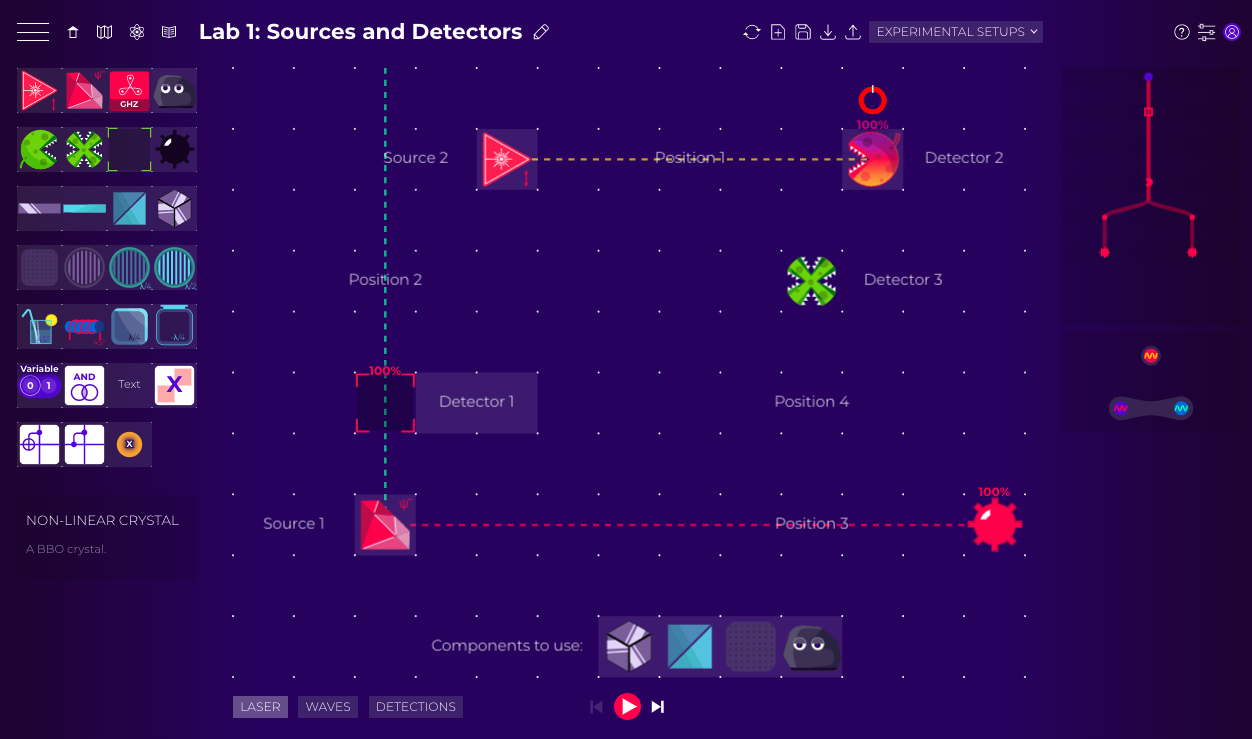

THE PHOTONIC TRAIL: A QUANTUM OPTICS TREASURE HUNT
Parihaven: Sources and Detectors
In this mission you will learn about sources, detectors, and a few more components in Quantum Flytrap’s virtual lab.
You seek the Hilbert Spade, an ancient, magical artefact that kingdoms once warred over before it was hidden away. They say the person who wields the Hilbert Spade can travel anywhere in spacetime by simply digging a small hole in the ground. They also say that only a Master of Light is worthy enough to attain this treasure.
In order to become such a Master you must traverse the ancient Photonic Trail, overcoming any obstacles in your way. Each successful mission takes you one step closer to becoming a Master of Light, one step closer to finding and wielding the Hilbert Spade.
Are you ready?
(Keep scrolling to reveal all the content or use the buttons to jump.)
Mission 1

Recommended listening:
Fantasy Village by The Vault of Ambience
Parihaven
Your journey begins in what appears to be an ordinary glade. Ordinary green grass and ordinary honey-colored flowers that gleam under a friendly sun. A smattering of ordinary trees rustling in the wind. Chirping birds and the splashes of calm waters from the shore nearby. All pleasant, yes. But ordinary.
You tread the Photonic Trail marked on your map, thinking that perhaps this adventure you embark on may be simple and straightforward after all. In no time will you be able to call yourself Master of Light.
But you are wrong.
For as you take a single step forward under a pair of particularly twisty old oaks, the landscape transforms in a blink to something rather…extraordinary. That’s the only word you can use to describe it.
Where the oak trees were a commonplace pair a moment before, they now harbor what appear to be dozens of tiny homes built right into them, homes with brightly lit windows, intricately carved balconies, and spiralled staircases. The homes are arranged in two colored clusters, one of pink and red, and one of blue, yellow, and green.
By your feet, a miniature brook babbles under a bridge no wider than your palm, and it runs alongside a little clearing that is decorated with strings of lanterns the size of pennies, an assortment of flower arrangements, and moss draping. At the center of the clearing are four lustrously polished marble pedestals that do not carry anything. The whole…village?…appears to bloom with radiant flowers the likes of which you have never seen before. Flowers that match one of the two housing clusters though never both, flowers that appear to move and dip and dart around the trees and fly.
It takes a moment for you to register that the flowers are not flowers at all, but creatures with tiny faces and even tinier wings where their shoulder blades would be.
A word surfaces from the depths of your memories, even as you gasp in realization. Fairies!
You have stumbled upon Parihaven, a fairy village.
Some fairies flitter about, fussing over decorations. Others play lutes and harps and more, a medley of instruments. Yet others frolic and dance and twirl. But what catches your eye is the largest group of them all, gathered around the empty pedestals in the clearing, fairies of warm colors to one side, fairies of cooler colors on the other. Above the pedestals, swirling upwards in the air in a manner too aggressive to be a dance, are the two largest fairies of all, each matching one of the two groupings of colors. They seem to be arguing, but their voices are too soft, too flute-like for you to decipher the words.
“That’s Mama Rosia and Papa Neel, the heads of the two families, doing what they do best,” says a voice. A green fairy with trailing yellow eyebrows, who appears no older than a teen, hovers above your right shoulder. He rolls his eyes to punctuate his words.
“Everyday it’s the same old story, the same old fight,” agrees another fairy, this one a bright crimson, flittering above your left shoulder. She sighs. “You’d think they enjoy it.”
“Think of all the extra time we’d have to celebrate if they weren’t always arguing!” says the green fairy.
“What are you celebrating?” you ask, curious and awed by these blithe creatures. The two fairies look at you as though you’ve suddenly grown a second head.
“Why, Tuesday, of course!” says the crimson fairy.
“And tomorrow we celebrate Wednesday!” the green fairy chimes in.
You mask a chuckle at their incredulity with a cough. The two introduce themselves as Phleep—“With a P-H!”—of the Blue Windrunners and Tock of the Red Petalpourers, secret best friends forever, in their words. They whizz around your head spilling their woes of living in a fairy village where there is such feuding between two families. What is their feud over? Why, decorations, of all things!
Every hour, Mama Rosia sends someone to rearrange the four statuettes on the pedestals. Every other hour, Papa Neel sends someone to revert the statuettes to his preferred arrangement on the pedestals. This carries on, day after day, and all the fairies in the village are left shaking their fingers at one another in accusation.
You also learn that even though you are practically a giant to them who has stumbled upon their village, the other fairies pay you no heed because they assume you cannot see them, hidden as they usually are from human eyes.
At this you exclaim, “Why then can I see Parihaven, and why then do you speak to me?”
Phleep and Tock exchange smiles that can only be described as ‘sneaky,’ but before you can open your mouth to ask them just what they are up to, Phleep stuffs a mushroom into your mouth and Tock clamps your lips shut with surprising strength, and you have no choice but to chew and swallow. At once Phleep, Tock, the trees, the houses, the brook, the clearing, grow, grow, grow around you, with such speed that you stumble back in dizziness. The two fairies, who are now the same size as you are, steady you before you have a chance to fall. Then it hits you like a slap in the face: they are not big at all. You are their size.
How on earth are you going to traverse the Photonic Trail to become a Master of Light now? Your heart races.
The two whisk you towards the clearing, grinning widely and ignoring your loud objections and attempts to flee.
“As fiesty as a dragon, this one,” Phleep comments to Tock under his breath.
“Got any fun memories we can placate the human with?” Tock whispers back. The two laugh as if Tock has made the cleverest of jokes, but you cannot see the humor in her comment or how it even makes sense at all.
They push you through the gathered fairies who watch the familiar argument play out above them. When you reach the four pedestals, you notice four statuettes lying on the ground, oddly shaped and unidentifiable, but beautiful nonetheless. The two quarelling heads-of-family notice you, and boy are they furious.
“Phleep! You brought a human to Parihaven??”
“This is just like you, Tock, how very irresponsible you are!”
Gasps and whispers erupt through the crowd. As the fusillade of accusations continues, your forehead beads with sweat, you shift from one foot to another, and you contemplate fleeing, even as Papa Neel threatens to lock you up.
Phleep and Tock raise their hands to quiet the crowd.
“This human may be able to help,” Phleep says.
“We figured we needed an outside perspective,” Tock adds.
“Let this traveler arrange the statuettes in a manner that pleases you both,” says Phleep. He shoots you a sly grin before continuing. “And if this proves unsuccessful, you can do whatever you want with the human!”
You very much object to this but you don’t say anything; you would rather not dig your own grave!
Mama Rosia and Papa Neel graciously yet skeptically agree to these conditions, and now it seems you have no choice but to lend a decorating hand.
Your task is this, traveler: there is only one optimal configuration for the statuettes on the pedestals. Find it, or be forever at the mercy of the fairies in Parihaven!

Lab Mission 1
Welcome to your first lab mission! In this lab you will learn about sources, detectors, and a few more components in Quantum Flytrap’s virtual lab. You will use what you learn to settle the quarrel between the two fairy families!
Since this is your first lab, let’s cover what you see on screen.
The Quantum Flytrap Virtual Lab
The central area is your experimental table—consider it the area in which you will perform experiments just like a real-life lab! (Don’t forget to grab your goggles.)
Under the experimental table you may notice three different modes: “Laser”, “Waves” and “Detections”. The Laser mode is enough for now, but you will investigate the other two in a later mission.
The panel on the left has a bunch of curious-looking shapes and objects. These are all the optical elements available in Quantum Flytrap to build a lab! Hovering over an element allows you to see what it is called, along with a small explanation.
By dragging different elements from the element panel and placing them on the experimental table, different experimental setups can be created. Each element’s direction can be changed by clicking on it, and each element’s properties can be read and tinkered with by right clicking on it.
But wait a second—there already is stuff on your experimental table! We have prepared the table for your lab mission, and the only components you need are already provided, labelled “components to use.”
Let’s start the hunt!
The Mission
Your task in this mission is to play with four provided components and see how they affect light beams and detectors. Namely, the four provided components should be placed in the positions marked 1-4 in such a way that Detector 1 has 200%, Detector 2 has 0%, Detector 3 has 25%, and the mine is 50% activated. There’s only one way to do this, and it’s the only way to make the fairies happy!
Where should each of the four components go such that: Detector 1 has 200%, Detector 2 has 0%, Detector 3 has 25%, and the mine is 50% activated?
Note: the lab should look like this:

If you don't see the complete lab, try zooming out (Ctrl/Cmd -), or click on the lab url here.
About this Lab
In order to play with light, we need some light sources. That is, devices that emit light. In the virtual lab there are 2 different light sources, and both of them are on your experimental table.
Sources
First source, the laser: You see the red triangle with what looks like a tiny firecracker inside of it? That’s a laser! A laser emits light through a process known as stimulated emission of radiation. It’s the most commonly used source of light in quantum optics labs. There are all kinds of lasers that can emit beams of different colors and brightness! Here, the laser’s emission is represented by a moving dashed line, and its brightness shows how bright the light is.
Second source, the crystal: Now take a look at the item on your table that looks a little like a luscious ruby. It’s actually a crystal, specifically, a non-linear BBO (Beta-Barium borate) crystal. Notice that it emits two light beams instead of one. These beams have curious properties you’ll get to explore in a later mission, but for right now all you need to know is that the crystal is a light source that emits two beams.
Now that you’ve got sources down pat, it’s detector time!
Detectors
Light is made up of small building blocks called photons. A photon detector registers whether photons have arrived where the detector is placed, which in turn allows us to register experimental results, and to test and observe quantum mechanics predictions. What’s truly cool is that we can not only detect a bunch of photons, we can detect even a single photon! Think about that for a moment. We can see beams with our eyes, but we cannot see a single photon! For a detector to be able to do this is truly astounding.
In Quantum Flytrap’s virtual lab, there are four different detector types: a simple detector, an omnidirectional detector, a non-destructive photon detector, and a mine.
Detector 1, the non-destructive photon detector: Do you see that square with 100% on top labeled Detector 1? That is a non-destructive photon detector. It passively detects light from any direction without doing anything to it; the photons can continue their journey without disruption. The 100% marks how much of the beam passes through it!
Detector 2, the simple detector: The hungry red flytrap marked Detector 2 is a simple detector, which detects incoming light from one direction, amplifying the signal for each single photon and making it readable. When no light is detected, the flytrap is green in color!
Detector 3, the omnidirectional detector: The little monstrous green flytrap with four mouths marked Detector 3 is an omnidirectional detector. It’s similar to the previous one, but capable of detecting light from the four main directions (left, right, up, down), one per mouth. It, too, becomes red upon light detection.
Detector 4, the mine: This is a detector that has no real life equivalent, since physicists don’t risk mines and explosions in real labs. But because we’re all virtual here, we have license to play with it without risking limbs. This peculiar detector in the virtual lab is activated to explode if even a single photon hits it, and turns a bright red to indicate when it’s been activated. What’s interesting about this is the difference between it and the other detectors: the other detectors provide information about photons through readouts, whereas for the mine, it’s an explosion!
Now, what do the percentages above each detector mean?
In Quantum Flytrap’s Laser mode, the percentage above each detector shows how much light emitted from a source ends up at that detector. The amount of light a source emits is always considered 100%. However, something usually occurs during the light beam’s travel, and that’s why we don’t always see the total emitted light arriving at the final detectors. A detector may have, say, 37% above it, which means only 37% of the photons emitted by the light source have arrived at the detector.
The light-travel is determined by the other optical elements: let’s explore them! We’ve picked four components for you to play with, so you can see just how they affect the light beams. Incidentally, these are the four components the fairies have statuettes of in their clearing!
The Four Components
The Corner Cube is a cube made of mirrors, so it reflects the incoming light from any of the four main directions.
The Absorber is a filter that absorbs a percentage of the incoming light. Absorbers can be used to make a light beam weaker, because only part of the original beam continues its quantum optical journey. Above the absorber you will see the percentage of the laser beam light that is absorbed, compared to the amount of light emitted from the source. On your experimental table, we’ve set the absorber to 50%. This can be adjusted by right-clicking the absorber, however, that isn’t required for the current mission. (Feel free to play with the percentage on your own, of course!)
The Rock is—drumroll please—a rock. Literally! It blocks all incoming light. Imagine you are pointing a laser at a rock, wall, pillow or whatever. You will never see the laser’s light on the other side because they block it completely!
The Polarizing Beam Splitter divides an incoming beam into two separate beams, where one of the beams continues in the same direction as the original beam and the other propagates perpendicularly to the original one as though it is reflected by a mirror at 45 degrees to the beam’s path. At this point you might be wondering, how does a beam splitter divide a beam, and what happens if there’s just a single photon? And, ehi, what does polarizing even mean? You’ll discover the answers later on in your journey!
For now, focus on appeasing the fairies by playing with the four components provided. Drag and drop them to their proper positions!
Question to complete the mission and move on to the next one:
Where should each of the four components go such that: Detector 1 has 200%, Detector 2 has 0%, Detector 3 has 25%, and the mine is 50% activated?
Tip: the Home Page of the Photonic Trail has a guide on how to use this Google form.
Was your mission successful? Do you have the password to unlock the next mission?
On to the next mission you go, traveler!
Or go back to the Photonic Trail Home Page:
Contact
Social
Menu
© 2020-2025 Algorithmiq QPlayLearn. All rights reserved.